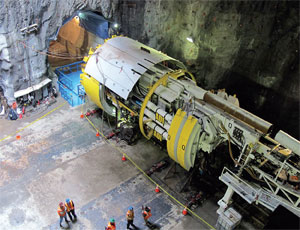Carrying both commuters and water, tunnels have long snaked through the bedrock beneath New York City, but now the labyrinth is growing: Multiple projects are under way totaling nearly $2.5 billion, with several other tunneling jobs on the horizon.

“Everyone wants these projects done as soon as possible, so we have a flurry of underground activity,” says Gary A. Almeraris, vice president of Skanska USA Civil, Whitestone, N.Y., which has major contracts on three of the region’s biggest tunneling jobs. “This is good news for the New York construction industry, and we expect the underground market to help us carry the rest of the construction industry through these very tough times.”
The Metropolitan Transit Authority alone is employing five tunnel-boring machines (TBMs) that are creating more than 12 miles of tunnel beneath the city.
The $2.1-billion No. 7 subway line extension aims to provide service to the Jacob K. Javits Convention Center on Manhattan’s West Side. S3II Tunnel Constructors—a joint venture of Skanska Civil, Secaucus, N.J.-based Schiavone Construction and J.F. Shea Construction, Walnut, Calif.—received the $1.14-billion tunneling contract. The JV has bored 9,400 linear ft of tunnel, connecting the Port Authority bus terminal at 42nd Street to 11th Avenue at 34th Street.
The $4.45-billion Second Avenue subway project will provide two tracks down Second Avenue, from 125th Street to the downtown financial district. The first of four phases entails building two tunnels, totaling 15,000 linear ft, from 96th Street to 63rd Street and Third Avenue, with new stations at 96th, 86th and 72nd streets and a refurbished station at 63rd Street. Another Skanska/Schiavone/Shea joint venture received the $350-million tunneling contract and have begun the work.
Begun in 1999, the $7.3-billion East Side Access project aims to increase the number of passengers the Long Island Railroad can bring into midtown Manhattan. Granite/Traylor/Frontier-Kemper Joint Venture—a partnership of Watsonville, Calif.-based Granite Construction, Evansville, Ind.-based Traylor Bros. and Frontier-Kemper, Pelham, N.Y.—received the $718-million Queens Bored Tunnels and Structures contract, which began in 2009. Dragados/Judlau—a joint venture of Dragados USA, New York City, and College Point, N.Y.-based Judlau Contracting Inc.—is working on the $450-million Manhattan tunnel.
Michael Horodniceanu, president of MTA Capital Construction, says bids for the projects have been extremely competitive, given the current state of the city’s construction market.
“What we have is a godsend for the construction market in New York because we are one of the biggest users of contractors,” he says. “People are hungry, and people are bidding. I expect to continue to get good prices.”
MTA plans to award most of its tunneling contracts by the end of 2012, with all projects wrapping up by 2016.
The biggest project on the docket in the New York City region is a third rail tunnel under the Hudson River, connecting New Jersey to midtown Manhattan. The $8.7- billion project, called Access to the Region’s Core (ARC), eventually will bore a 9-mile tunnel. On the New Jersey side, work on the $258.7-million Palisades tunnel...


Post a comment to this article
Report Abusive Comment